To make a jungle safari spine-chilling, breathtaking, and totally remarkable, you will need a driver-cum-guide who knows the jungle like the back of his hand, a freshly prepared unfenced camp site, a lean and dark Masai for protection, eerie animal sounds to garnish the night, and heaps and heaps of good luck for animal sightings.
Masai Mara National Reserve in Kenya is an extension of the Serengeti National Park in Tanzania. It comprises only 1500 square kilometres of the entire Mara-Serengeti stretch of 20,000 square kilometres, yet is a more preferred location because of the proximity to wild life. There are several camps inside the jungle that offer three or four day packages which include accommodation, meals, and of course the jungle safari.
We chose a camp called Keekorok that was in the centre of the reserve, and opted for their makeshift tent accommodation with unfenced territory as opposed to a more cocooned lodge stay, just for the thrill of it. The camps are made at carefully chosen locations, and we got some assurance from the fact that so far very few incidents of wild attacks had been reported within a camp. A lot of your own safety is also determined by how well you follow the jungle protocol. One of them would be that you must NEVER step out of the jeep when on safari.
The reserve gets its name from the Masai Mara tribe that inhabits the vast jungle, and is being lauded by environmentalists for their conservation techniques. It is essentially a hunting tribe but young Masais now find employment at camps and offer guard duties and accompany tourists to safaris. In the wake of the changing ecology and poaching threats, they have gradually shed a few of their traditional customs. Legend has it that once a Masai boy hit puberty, he would go to the jungle, hunt down a lion and bring his head as a souvenir and as a proof of his masculinity. Eventually, the diminishing lion population led to a ban on hunting and the Masais now lead a livestock-centric life. It is still a formidable tribe and whether it is the bloody red they wear or the odour of a Masai that drives a lion away, is still a matter of speculation.
As we entered the main gates of the reserve, we were advised by our driver Jacob to open the roof of the jeep and stand on our seats in anticipation of the forthcoming action. The appetizer itself was a rare delight. We sighted a baby rhino prancing about merrily in the pastures. Actually, it was lost, and was deliriously looking for its mother. Any African safari, we discovered, is a success if you manage to spot the big five –the lion, the tusked elephant, the rhinoceros, the buffalo, and the leopard. These animals have made it to the big five list because they are the most elusive.
Two days before our arrival, it had been raining which makes animal spotting rather tough but luck was shining on us and the baby rhino we saw was one of the 20 odd species in the jungle that have dwindled rapidly due to poaching in the past. The first day also offered us zebra, giraffe, wildebeest, warthog, deer, and antelope sightings. Still, the big cat eluded us.
Next morning before the break of the dawn, there was news of some lion activity in the Savannah. We jumped into the jeep and quickly reached the plain where seven other jeeps were already patrolling in two equidistant rows. The jeeps follow a protocol of remaining sufficiently distant from each other to avoid threatening or provoking the animals. There were three lions and they looked far from threatened as they brushed past the jeeps with their distinctly pompous gait. I was amazed at how self-aware, bold and powerful this animal was as each muscle in his limbs flexed with vigour at every step. We couldn’t get enough of the regal three and followed them till they disappeared into the tall grasslands.
It was definitely the day of predator sightings as we later chanced upon a group of cheetahs lazing in the morning sun. And just when I was thinking of lionesses–the females who actually do the hunting in the family; we spotted three of them sitting around with their cubs.
The Masai Mara reserve, functions on a correlative understanding between the Masais and the government and it shows. Neither interferes in the other’s work and both collectively work towards balancing the tourism and ecology of the forest. One such Masai gave us information of an elephant family grazing in the northern end. We were eager to see the ‘tuskers’ that have christened Kenya’s local beer brand. The family of five was at quite a distance yet each looked big enough to gawk at. We waited for them to come closer, until eventually they stopped fitting into the camera frame!
It was around lunchtime when we were presented with our real feast: a pack of seven lionesses, two lions and three to four cubs feasting on a buffalo’s body. Forgive me the graphic detail but even for someone as ‘gore sensitive’ as me, it was an amazing sight. Our jaws dropped and voices turned to whispers when we saw the action in progress –one of them tearing the flesh apart, another trying to snatch it, the cubs taking turns to dig in and the remaining lazing in the shade with full bellies.
A sight that was so far seen only on National Geographic was happening barely two feet away and it looked strangely spectacular. It was at that moment when it actually hit me that we’re in a jungle: a place or the only place where instinct rules everything. Anything and everything after this seemed trivial. Our eyes and mind were full of the image we just saw. For the rest of the drive every yellow-furred animal with a brown mane looked like a lion from afar.
Back at the camp after dinner, I feasted on stories of lion chases and a lion’s roar that can be heard from 50 kms away. Throughout the safari I hadn’t had a chance to hear the thunderous roar of a lion and my gaze wandered on the skull of a cow that the camp owner had placed atop a branch as a souvenir; and I asked myself, “Do I really want to hear that roar?”
Vidhi Salla is writer, blogger, movie buff and traveller. She writes movie reviews and also contributes informative travel articles to websites. She gave up a lucrative corporate career to pursue creative writing, that she strongly believes is her calling.






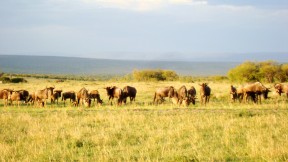
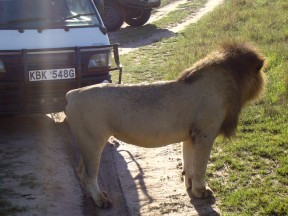
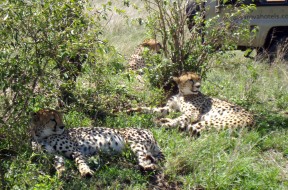
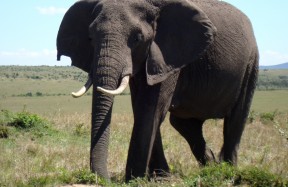
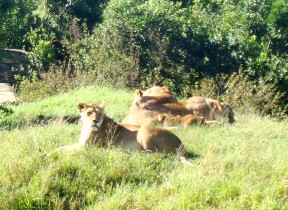
Spectacular! loved reading it.
Thank you 🙂 I equally enjoyed writing it